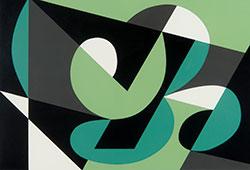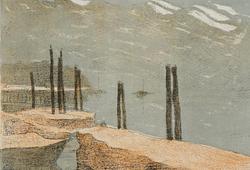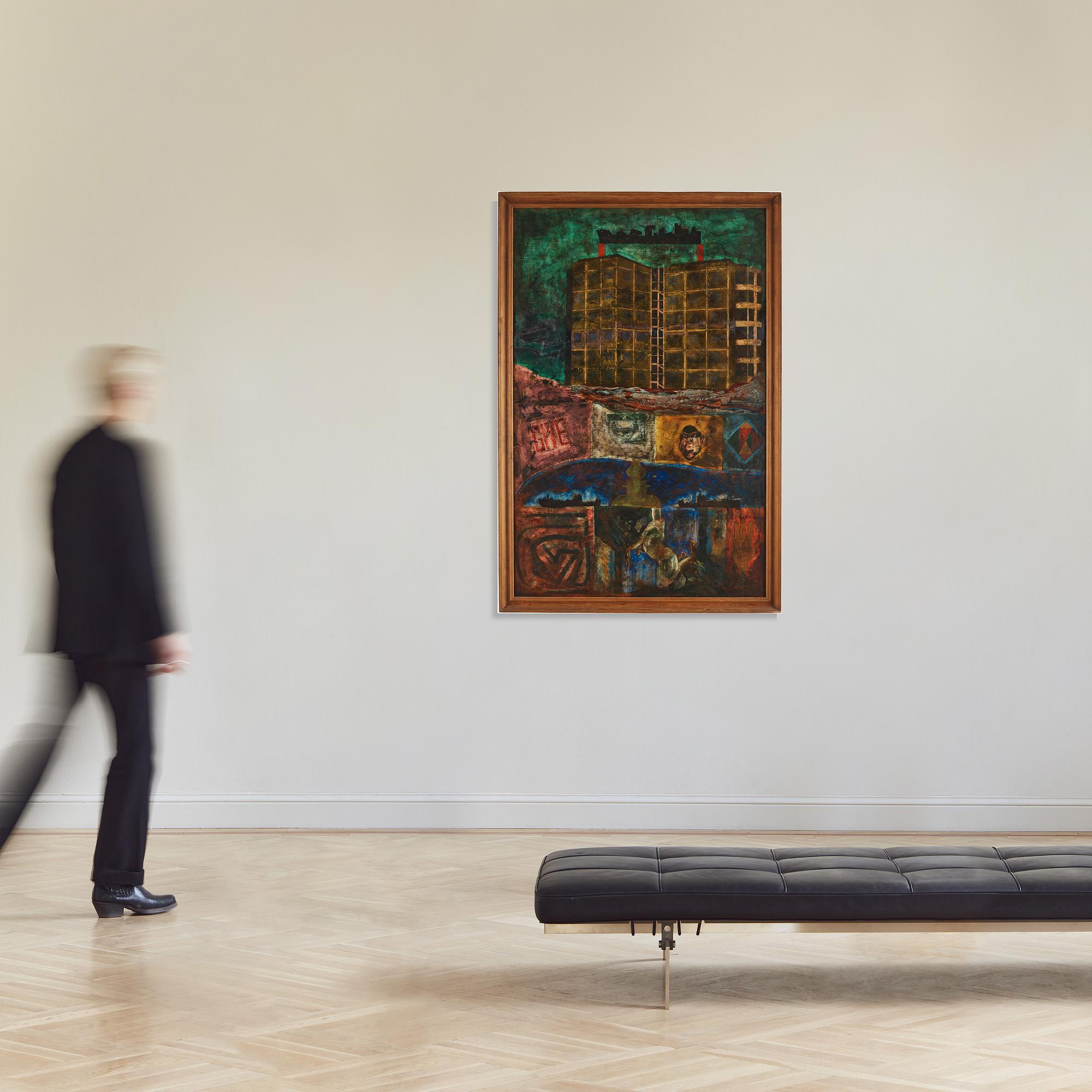Dick Bengtsson
"Vinter i Bandhagen"
Signed Dick Bengtsson verso. Executed in 1965. Oil on panel, divided in two 176 x 115 cm.
Provenance
The artist's family.
Exhibitions
Skarpnäcks konstförening, Sweden,"Ung generation 65", travelling exhibition 1965.
Moderna Museet, "Dick Bengtsson", 26 March - 15 May 1983.
Olle Olsson-Huset Hagalund, Solna, Sweden, "Dick Bengtsson", 10 September - 9 October 1988.
Lunds Konsthall, Lund, Sweden "Dick Bengtsson", 23 April - 29 May 1994.
Uppsala Konstmuseum, "Dick Bengtsson", 22 January - 9 April 2000, cat. no 39.
Göteborgs konstmuseum, Gothenburg, "Dick Bengtsson", 30 January - 25 March 2001.
Moderna Museet, Stockholm, "Dick Bengtsson", 21 January - 30 April 2006, cat. no 19.
Literature
Björn Springfeldt (Ed.), "Moderna Museets exhibition catalogue no 181", 1983, illustrated full-page.
Bo A Karlsson (Ed.), "Här bor Dick Bengtsson", 2005, illustrated p. 157.
Mårten Castenfors (Ed.), "Dick Bengtsson", SAK, 2005, Illustrated p. 125.
More information
In Dick Bengtsson’s early work 'Vinter i Bandhagen,' a seemingly abandoned high-rise towers over a desolate space, emptied of people. The image appears to be a commentary on post-war social engineering in Stockholm, where attempts were made to solve the severe housing shortage by creating entirely new communities outside the city center. The color palette is muted, and the apocalyptic atmosphere is heightened by the two warships that seem to be placed in the fountain of the open space. The foreground is framed by a series of symbols, heraldic signs, graffiti, and fragments of abstract compositions. It is a rebus, a reverse allegory that opens up a labyrinth of interpretations, depending on which position one chooses. With his enigmatic paintings, Dick Bengtsson has, since the sixties and with renewed strength today, fascinated and impacted new generations of viewers.
Mårten Castenfors writes in the foreword to Saks’ publication 'Dick Bengtsson,' 2005:
'Like few others, the self-taught Bengtsson, with his fragmentary painting and cryptic installations, has inspired and fascinated a younger generation of artists. With his symbols, his at times provocative swastikas, and his paintings patinated by ironing, Bengtsson emerges as an iconoclast, but also as a rational romantic, as complex as he is playful, as bold as he is strict. Bengtsson’s painting and installations strike with great mystery, sweeping in the memory of the past, while this memory also foreshadows a welfare state on the brink of collapse.'
In front of a work by Dick Bengtsson, one is never quite sure of the meaning of the various components. His art is filled with mystery and poses more questions than it answers. In his multi-layered world, one is forced to challenge values and patterns of association; it demands the viewer’s full attention. It is difficult to distinguish between truth and fantasy, and he himself described his paintings as a form of reality distortion. A sharp observation of details is combined with charged symbols and visual elements in a spatial depiction that is highly unclear. The fall of light adds to the mystery, seeming to come from within the motif, and there are no clear shadows.
Douglas Feuk has described Dick Bengtsson’s motifs as neither created after nature nor according to any traditional rules of art. The artist’s imagination required support from photographic templates, which could be images from magazines, art books, encyclopedias, or similar, forming the basis for a new painting. The template was transformed into a line drawing that, through a laborious copying technique, was transferred and enlarged to the desired format. Consequently, no sketches existed; what was preserved in the artist’s archive were line drawings and the transparent or grid-lined papers used in the process.
Dick Bengtsson is one of the country’s most important and influential artists. With his critique of modernism’s over-reliance on a single truth, he was an early precursor of postmodernism. By never accepting that there is only one correct way to interpret something, his art raised previously unaddressed questions. He is said to have remarked, 'The problems begin outside the picture frames.' His fellow artists and a circle of collectors and museum professionals recognized his greatness even during his short lifetime, and he was spoken of as an 'artist’s artist.' Even today, we see clear traces of his influence on contemporary Swedish art.
The Swedish artist Mamma Andersson describes her first encounter with Dick Bengtsson’s art when she worked as a museum guard in the 1980s: 'For several years, I started my workdays with a cup of coffee and a look through the worn-out 1983 catalog from Moderna Museet. It’s hard to pinpoint what it was that captivated me so much. One thing is certain: it was liberating to encounter an artist who was so unpretentious, independent, and completely unsentimental. Painting after painting is made in an awkward, slow, and hauntingly beautiful way. Suddenly, everything was allowed and forgiven; it was just a matter of painting and trusting your innermost dreams and nightmares. I had a feeling that he disregarded the established rules of painting and trusted only himself.'
Photo: Bandhagen, Bandhagsplan, postcard Pressbyrån 30663.
Photo: Dick Bengtsson in front of 'Turister på Hawaii,' Minette Hollimon's archive."























































































